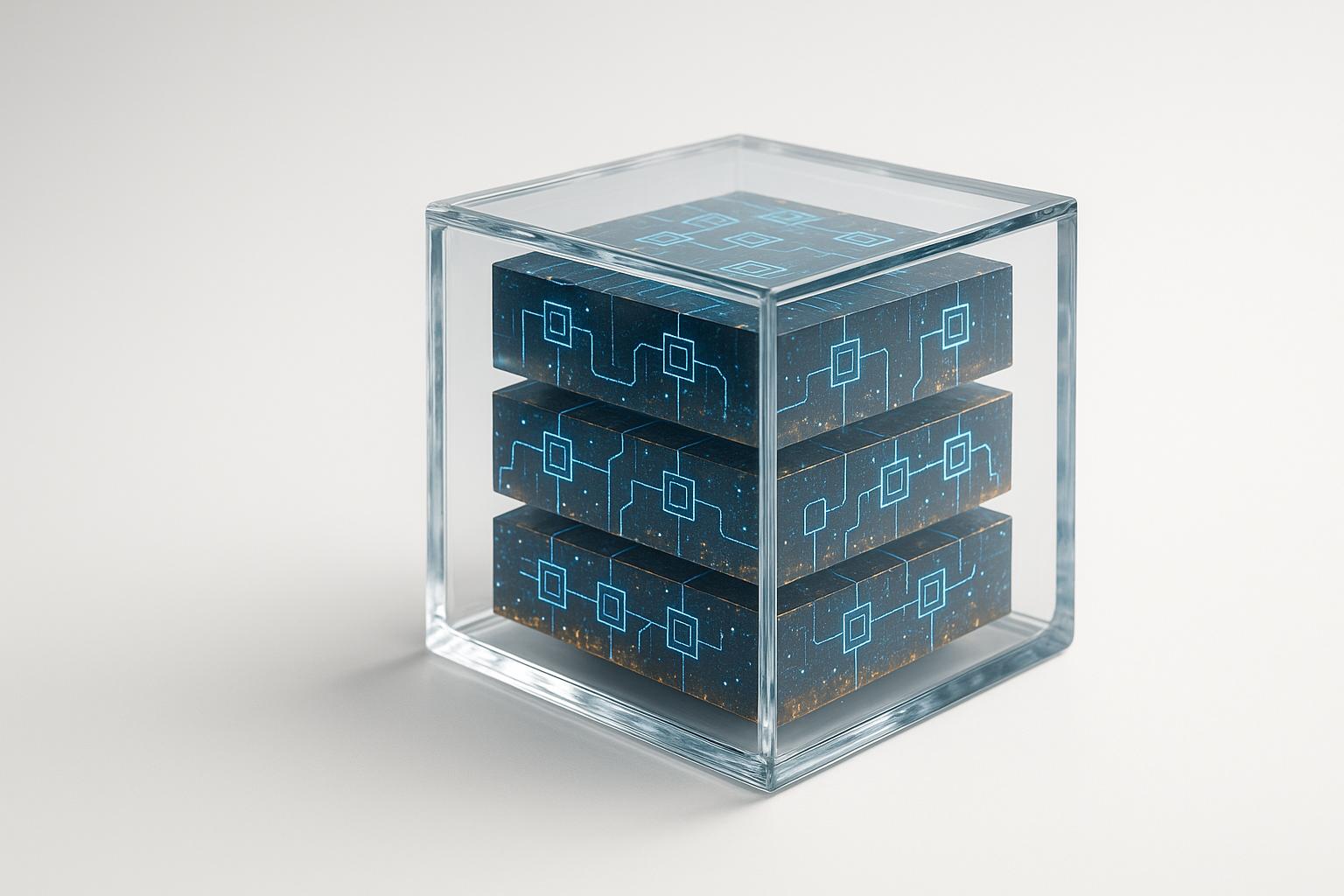Customizable audio watermarking is a powerful tool for securing digital audio content against manipulation and unauthorized use. This technology allows users to fine-tune aspects like watermark detection, message size, and sound quality to meet specific needs. It’s increasingly used in areas like deepfake detection, broadcast monitoring, and copyright protection.
Here’s a quick overview of four leading solutions:
- WaveVerify: Offers flexible watermarking but lacks transparency on technical details.
- AudioSeal: Uses neural networks for precise, sample-level watermarking and handles audio distortions well.
- WavMark: Focuses on frequency-domain protection but requires higher resources.
- ScoreDetect: A blockchain-based system that avoids embedding watermarks, preserving original audio quality while proving ownership.
Each solution caters to different priorities – whether it’s securing content during distribution or establishing ownership with legal proof. Below is a comparison of their strengths and trade-offs.
Quick Comparison
| Solution | Detection Accuracy | Audio Quality | Integration Options | Cost | Ownership Proof |
|---|---|---|---|---|---|
| WaveVerify | High | High | Moderate | Moderate | Good |
| AudioSeal | Very High | High | Python API | Moderate | Good |
| WavMark | High | High | Limited | Higher | Good |
| ScoreDetect | Good | Perfect | API, Plugins | Variable | Blockchain-based |
This guide will help you choose the right tool based on your specific business needs.
UOC’s Audio Watermarking System, High-fidelity recovery under extreme conditions
1. WaveVerify
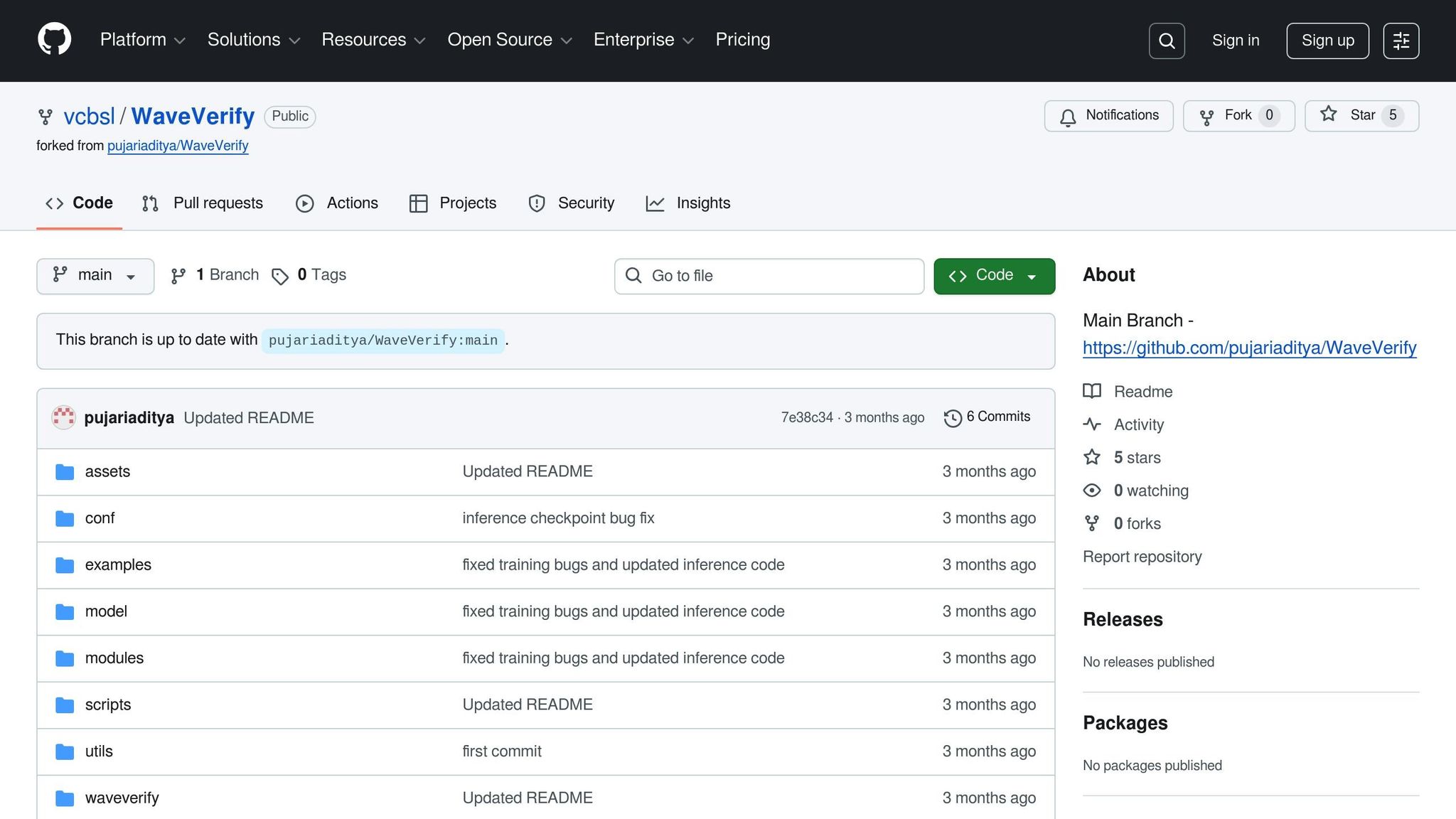
WaveVerify provides a solution for audio watermarking that can be tailored to specific needs. However, there’s limited publicly available information about its embedding techniques, how well it holds up against audio distortions, or the ways it can be integrated into different systems. This lack of clarity makes it tough to fully evaluate its effectiveness and flexibility. Up next, we’ll take a closer look at AudioSeal to see how it approaches these challenges differently.
2. AudioSeal
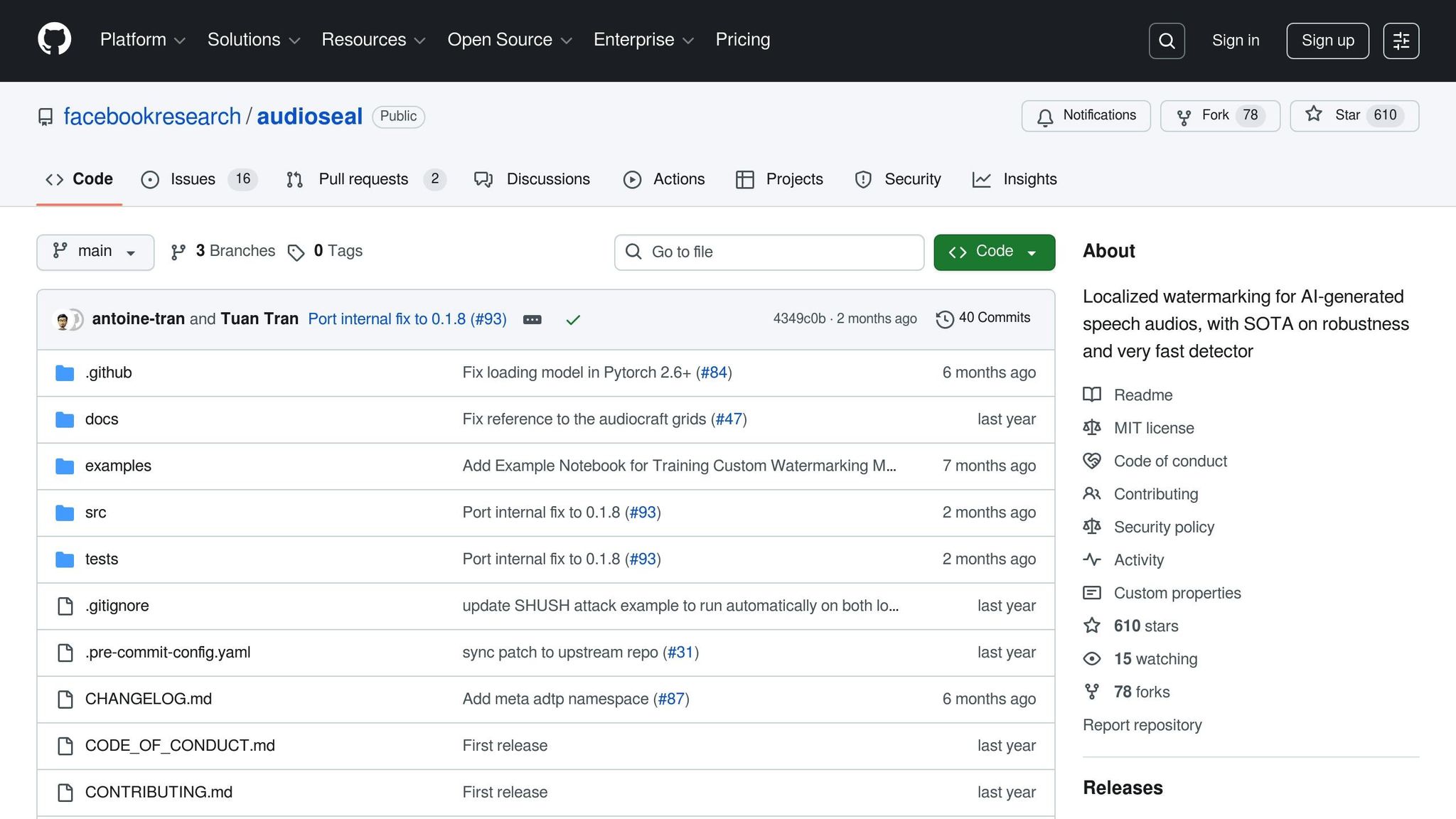
AudioSeal is an open-source audio watermarking tool that takes a modern approach by leveraging neural networks to embed watermarks directly at the waveform level[3]. This advanced method sets it apart from earlier solutions like WaveVerify.
Embedding Method
AudioSeal uses convolutional layers alongside techniques like ISTFT, IDWT, and IDCT to embed and extract watermarks from audio files[1]. Designed specifically for 16kHz audio, it embeds watermarks at each sample, allowing detection at intervals as short as 1/16,000 of a second. This precision ensures consistent performance across standard business applications[3].
Robustness
One of AudioSeal’s standout features is its ability to handle real-world audio distortions. It’s trained to endure compression, noise, and filtering, which are common hurdles for traditional watermarking methods[1]. During its development, these distortions are simulated to enhance its durability.
The system performs exceptionally well even in difficult environments. For example, it can achieve near-perfect detection accuracy using just two seconds of audio, even when faced with acoustic challenges like speaker-to-microphone distances of over 20 feet[2].
Customizability
AudioSeal supports embedding a 16-bit customizable watermark message, enabling businesses to tailor payloads to their specific needs[3]. This flexibility allows companies to encode a variety of information directly into their audio content.
The detection process not only identifies the presence of a watermark but also retrieves the embedded message, offering robust verification options that can be adapted to different security requirements[3].
Integration Options
As an open-source tool, AudioSeal provides extensive integration options through its Python API[3]. Businesses can seamlessly incorporate it into their workflows and customize it for specific operational needs.
The system supports both high-level and low-level detection, making it suitable for a range of use cases, from straightforward verification tasks to complex content management systems[3].
Business Features
AudioSeal prioritizes audio quality by evaluating fidelity using metrics like SNR, PESQ, and ViSQOL, ensuring minimal impact on how the audio sounds[1]. This focus on quality is essential for industries that can’t afford to compromise on audio clarity.
Its performance is measured using False Positive Rate (FPR) and False Negative Rate (FNR), providing clear insights into detection accuracy[1]. These metrics allow businesses to gauge the effectiveness of their content protection strategies.
Additionally, the system uses shorter, repeated noise patterns to enhance detection accuracy, particularly in challenging scenarios like broadcasts or second-screen applications[2]. Next, we’ll explore WavMark’s distinct approach to audio watermarking.
3. WavMark
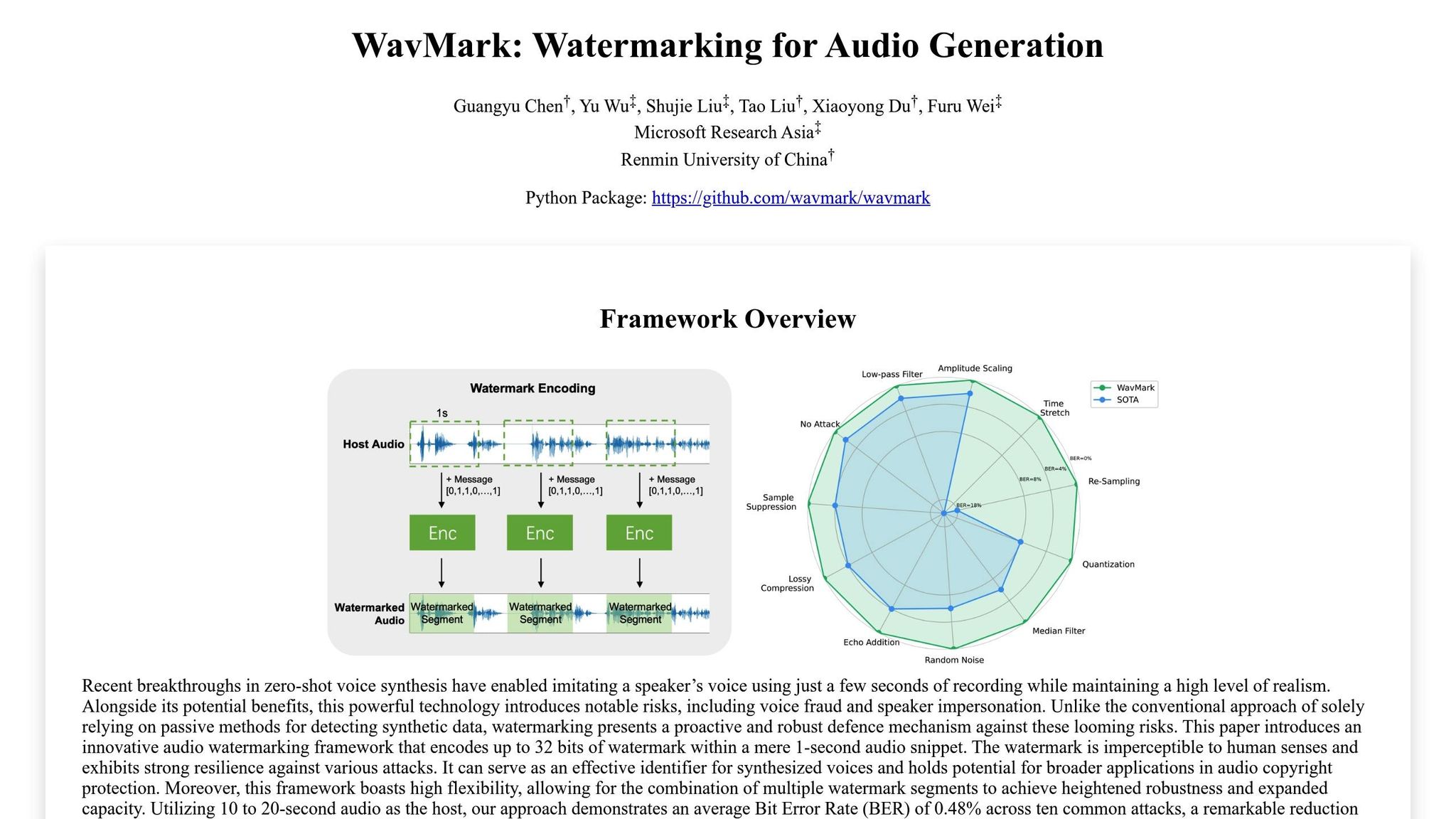
Unlike AudioSeal, which provides extensive details, WavMark’s technical documentation is relatively sparse. While it’s promoted as a flexible audio watermarking tool, specifics about its key features – such as how it embeds watermarks, its ability to withstand audio modifications, and its integration capabilities – remain unclear. For a deeper understanding, it’s best to explore the vendor’s resources directly.
sbb-itb-738ac1e
4. ScoreDetect
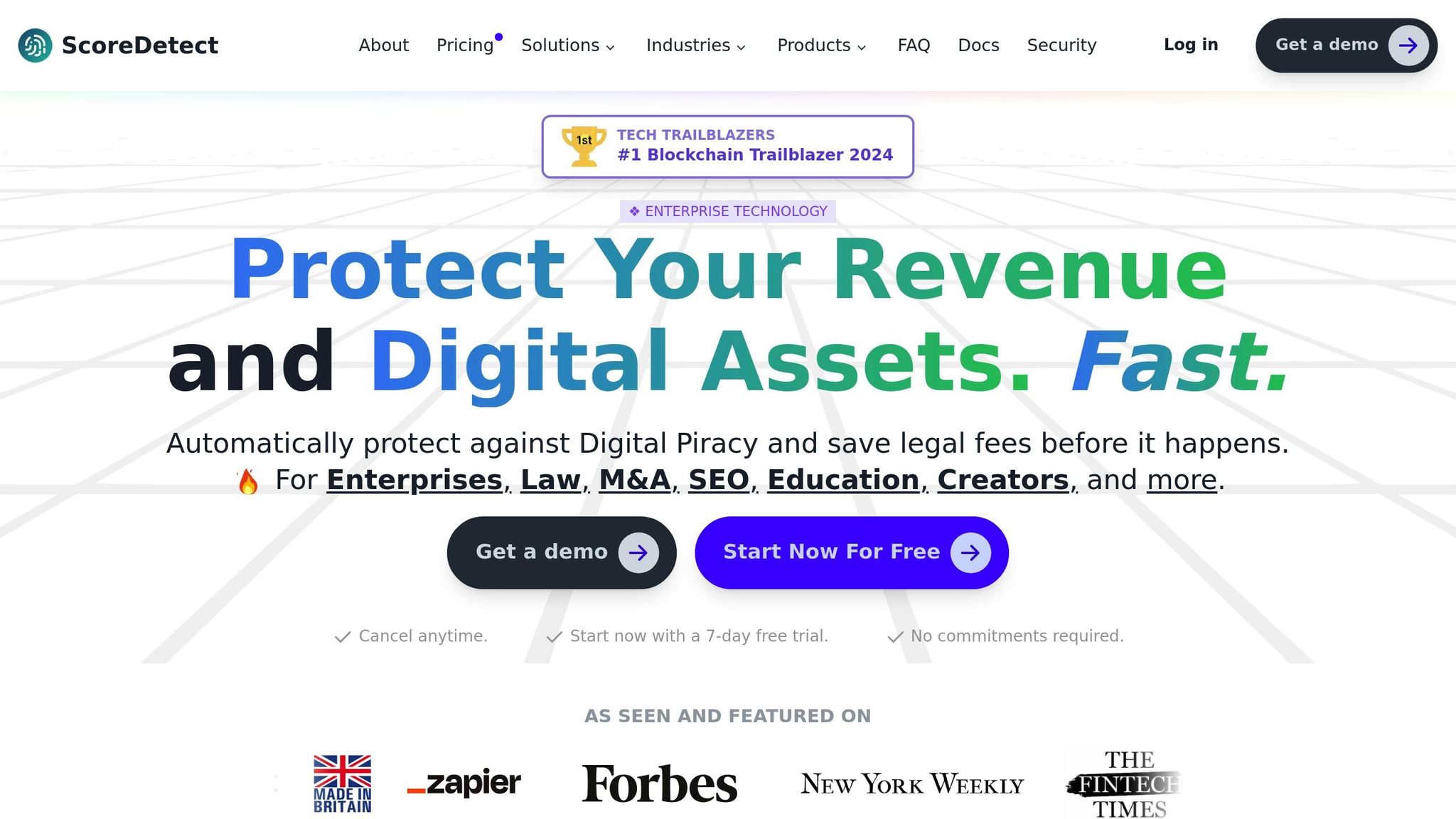
ScoreDetect takes a fresh, non-intrusive approach to watermarking by using blockchain verification instead of embedding markers. This ensures audio quality stays intact while providing robust protection.
Embedding Method
ScoreDetect creates a unique audio hash through a checksum stored on the SKALE blockchain. This process generates an unchangeable timestamp and proof of ownership, all without altering the audio file itself. The result? Your audio remains in its original, pristine condition.
Robustness
This blockchain-based method is highly resilient. It safeguards your content against compression, pitch alterations, or even re-recording. The blockchain record acts as tamper-proof evidence, which can be crucial in legal disputes to prove ownership or establish the exact creation date.
Customizability
ScoreDetect allows you to personalize verification and recognition certificates with details like copyright information and work titles. Each certificate includes the registration date, copyright data, and official signatures. The platform caters to over 15 industries, such as media, entertainment, legal services, and marketing. Enterprise clients can access tailored integrations and advanced features to meet specific business needs.
Integration Options
ScoreDetect works seamlessly with tools like Zapier, WordPress, WooCommerce, and APIs to simplify content protection. These integrations enable automated workflows, such as generating verification certificates for new audio uploads, securing content within content management systems, and boosting SEO with enhanced Google E-E-A-T signals. Businesses can also embed verification features directly into their proprietary systems.
Business Features
In a world filled with AI-generated content and deepfakes, ScoreDetect helps establish trust and credibility. Its blockchain verification system proves ownership and provides a timestamp that’s easy to verify. Built on the SKALE blockchain, it offers zero gas fees and an eco-friendly design. Enterprise plans include 24/7 content monitoring, automated takedown notifications with a success rate exceeding 96%, and access to dedicated success managers.
"ScoreDetect is exactly what you need to protect your intellectual property in this age of hyper-digitization. Truly an innovative product, I highly recommend it!" – Imri, Startup SaaS, CEO
"With ScoreDetect, I can take pictures for my travel blog and be confident that nobody will claim them as theirs. I can always prove that I am the author." – Kyrylo Silin, SaaS Founder, CEO
Advantages and Disadvantages
Knowing the upsides and downsides of different watermarking tools is key to selecting the right strategy for your business. Each option comes with its own set of trade-offs, affecting how well it protects your content.
WaveVerify uses a FiLM-based generator that delivers zero BER (bit error rate) under normal distortions and achieves MIoU scores above 0.98, even with heavy modifications. It reduces training time by 80%, but it does require technical expertise and comes with moderate costs.
AudioSeal specializes in precise, sample-level watermarking for AI-generated audio, encoding up to 16-bit messages with impressive detection accuracy. However, it only supports audio at 16kHz, which can limit its use.
WavMark emphasizes strong frequency-domain protection, ensuring watermarks remain intact after multiple processing steps. This durability, however, comes at the cost of higher expenses and increased computational demands.
On the other hand, ScoreDetect takes a completely different approach. Instead of embedding watermarks, it uses a blockchain-based system that guarantees 100% audio quality. Ownership is verified through blockchain certificates, which serve as unchangeable proof. ScoreDetect also integrates seamlessly with popular tools and offers automated workflows, all while avoiding gas fees on the SKALE blockchain. However, it doesn’t support traditional watermark tracking methods.
Here’s a quick comparison of the key trade-offs between these solutions:
| Solution | Robustness to Attacks | Audio Quality | Scalability & Automation | Cost of Implementation | Traceability & Legal Proof | Unique Features |
|---|---|---|---|---|---|---|
| WaveVerify | Strong | High | Automated | Moderate | Good | FiLM-based multiband embedding |
| AudioSeal | Good | High | Automated | Moderate | Good | Localized watermarking |
| WavMark | Durable | High | Automated | Higher | Good | Frequency-domain robustness |
| ScoreDetect | Very Good | Perfect | Highly Automated | Variable | Blockchain-based | Web scraping, takedown, plugins |
Cost considerations vary widely among these tools. For example, ScoreDetect offers a 7-day free trial and includes advanced features in its Enterprise plans, with a focus on affordability through its zero gas fee blockchain model. Meanwhile, traditional watermarking tools like WavMark often require a higher initial investment but may provide different long-term benefits depending on your specific needs.
Resource demands also differ significantly. ScoreDetect keeps things simple by avoiding the storage of digital assets altogether – only checksums are processed locally and stored on the blockchain. This reduces both storage needs and security risks. On the flip side, tools like WaveVerify and AudioSeal, which rely on AI, demand more computational power for tasks like training and processing but offer the advantage of embedded protection that stays with the content.
So, how do you decide? Use embedded watermarking if you need protection during content distribution. Opt for blockchain verification if your priority is clear ownership proof and automated legal workflows.
Conclusion
Customizable audio watermarking solutions can be divided into two main approaches: embedded techniques and blockchain-based verification, each catering to different business priorities.
Embedded watermarking tools like WaveVerify, AudioSeal, and WavMark excel in maintaining high audio fidelity while minimizing bit error rates. However, they require precise parameter adjustments to perform effectively.
On the other hand, ScoreDetect’s blockchain verification skips embedded marks entirely, preserving the original audio quality while offering immutable proof of ownership. Its standout feature is the extensive customization offered through the Enterprise plan, which supports advanced functionalities and custom integrations tailored to unique business needs. Choosing between these approaches depends on whether your focus is on protecting content during distribution or ensuring verifiable ownership.
Grasping these technical differences is key to identifying the right solution for specific industries. U.S. businesses, for example, need tools that align with local legal requirements, formatting standards, and seamless compatibility with platforms like WordPress and Zapier.
Recommendations vary by industry:
- Media and entertainment professionals benefit from blockchain verification, which ensures authenticity – a critical need in combating AI-generated deepfakes.
- Legal and law firms require tools with verifiable timestamps and ownership certificates to support intellectual property cases.
- Marketing agencies and SEO companies can use blockchain timestamping to boost Google E-E-A-T signals and improve search rankings.
Emerging AI-driven, dataset-free methods add another layer of flexibility, requiring no extensive training. Their performance is evaluated using metrics like SNR, PESQ, and ViSQOL, ensuring high-quality results without compromising efficiency.
FAQs
How does ScoreDetect use blockchain technology to protect audio content and verify ownership?
ScoreDetect strengthens copyright protection by recording a checksum of the audio content on the blockchain. Instead of storing the actual files, this method secures proof of ownership while maintaining the original quality of the content. It offers a reliable and tamper-proof way to verify authenticity.
What are the benefits of customizable audio watermarking for detecting deepfakes and protecting copyrights?
Customizable audio watermarking provides an effective solution for detecting deepfakes and protecting intellectual property. By embedding subtle, non-intrusive, and nearly invisible watermarks, it safeguards audio content from unauthorized use while preserving its original quality.
Tools such as ScoreDetect take copyright protection a step further by issuing verification certificates that confirm ownership of digital assets, including audio files. This technology empowers businesses and creators to manage and secure their content with confidence in an increasingly digital world.
What integration options does ScoreDetect offer, and how can they benefit businesses?
ScoreDetect connects with over 7,000 web apps via Zapier, making it easy for businesses to automate workflows and simplify processes. By linking existing tools and platforms, companies can save time and work more efficiently.
On top of that, ScoreDetect offers a WordPress plugin that automatically records every published or updated article, creating a secure, blockchain-based proof of ownership. This bolsters copyright protection while also boosting SEO, making it a powerful solution for businesses managing digital content.

